Never Judge a Book by its Cover: Why Advisors Must Look Beyond ESG Labels
Based on the following fund profiles, can you pick the ESG strategy?
Fund 1 (U.S. large cap blend category)
Morningstar Sustainability Rating: 5 Globes
Historical Sustainability Score Percent Rank: 11th
Historical Sustainability Score (lower score = lower risk): 22.16
Current Sustainability Score (lower score = lower risk): 22.33
ESG Breakdown (lower score = lower risk):
- Environmental: 4.16
- Social: 10.76
- Governance: 7.40
Fund 2 (U.S. large cap blend category)
Morningstar Sustainability Rating: 3 Globes
Historical Sustainability Score Percent Rank: 40th
Historical Sustainability Score (lower score = lower risk): 23.52
Current Sustainability Score (lower score = lower risk): 23.32
ESG Breakdown (lower score = lower risk):
- Environmental: 3.81
- Social: 9.94
- Governance: 7.08
Current Sustainability Scores based on 98% of AUM | Global Category: US Equity Large Cap Blend |3166 Funds in the Global Category | Sustainability Scores as of Jul 31, 2020. Sustainability Rating as of Jul 31, 2020.
Surprisingly, only Fund 2 has an ESG label. We won’t name the competitor but will simply point out that it comes from a large asset manager and that the fund has ESG in its title. The first fund is Dana’s own large-cap U.S. equity fund. If you didn’t judge by the title, it could easily be classified as an ESG strategy.
We compare the two funds not to disparage a competitor – Fund 2 also scores quite well on ESG metrics and edges Dana’s fund on some factors – but to show that a fund doesn’t have to have ESG in its title to incorporate ESG principles or score well on ESG ratings.
At Dana, our funds all incorporate ESG principles, not because it makes for better marketing, but because we think it provides a more holistic view of a company’s underlying risk. Our large-cap fund and our Dana Epiphany ESG Fund share a portfolio manager. He often says that he can’t unlearn what he has learned. In other words, he naturally looks at companies through an ESG lens, regardless of what fund he is managing. The same holds true for our analysts.
Like-minded investors and advisors who believe adhering to ESG principles can help fund performance and diminish risk may want to expand fund searches beyond just ESG-labeled strategies. As the comparison shows, many other funds are more ESG-friendly than their title suggests.
*ESG investing involves the consideration of environmental, social and governance factors as part of the decision-making process when investing in stocks.
The Morningstar Sustainability Rating is a measure of how well the holdings in a managed investment are managing their environmental, social, and governance, or ESG, risk relative to its peer group. To arrive at the Morningstar Sustainability Rating for a fund, Morningstar first calculates an asset-weighted roll-up of the ESG Risk Rating from Sustainalytics of the holdings in each portfolio from the most recent 12 months. To receive a score, at least two thirds of a portfolio’s asset must have a company ESG Risk Rating. Next, portfolio scores are aggregated using an exponentially weighted average that weights recent portfolios more heavily than older ones. The resulting overall fund score ranges between 0 to 100 and is rendered on the same scale as company ESG Risk Ratings: Lower scores are better, indicating lower portfolio ESG risk. Based on these scores, portfolios are compared with their Morningstar Global Category peers. The Morningstar Sustainability Rating is then assigned to all scored funds within Morningstar Categories in which at least thirty (30) funds receive a Portfolio Sustainability Score and is determined by each fund's rank within the following distribution: High (highest 10%), Above Average (next 22.5%), Average (next 35%), Below average (next 22.5%), Low (lowest 10%). The Morningstar Sustainability Rating is depicted by globe icons where High equals 5 globes and Low equals 1 globe. Since a Sustainability Rating is assigned to all funds that meet the above criteria, the rating is not limited to funds with explicit sustainable or responsible investment mandates. Morningstar updates its Sustainability Ratings monthly. Please click on http://corporate1.morningstar.com/sustainableinvesting/ for more detailed information about the Morningstar Sustainability Rating methodology and calculation frequency.



